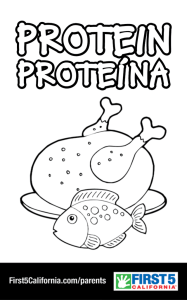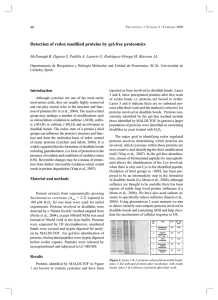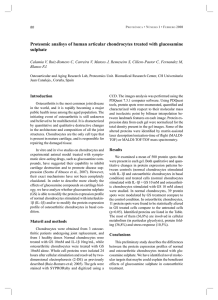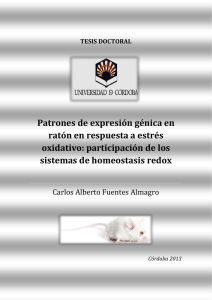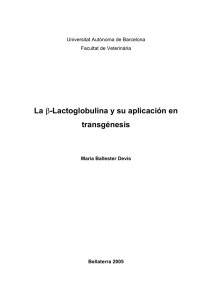pro39.pdf
Anuncio
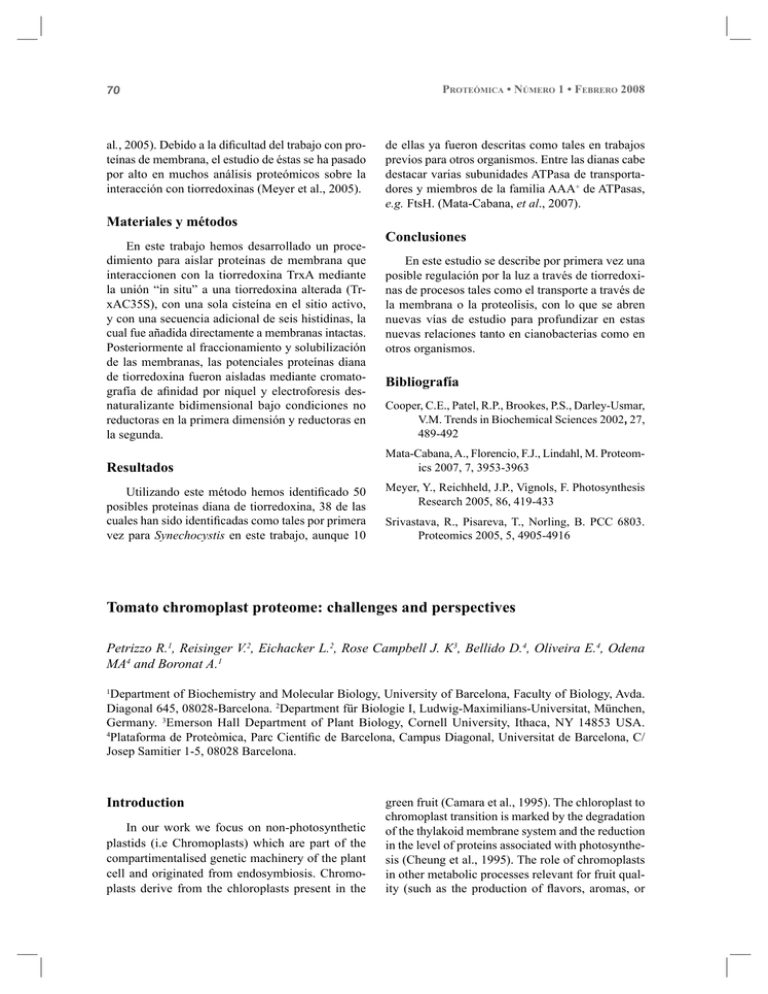
70 al., 2005). Debido a la dificultad del trabajo con proteínas de membrana, el estudio de éstas se ha pasado por alto en muchos análisis proteómicos sobre la interacción con tiorredoxinas (Meyer et al., 2005). PROTEÓMICA • NÚMERO 1 • FEBRERO 2008 de ellas ya fueron descritas como tales en trabajos previos para otros organismos. Entre las dianas cabe destacar varias subunidades ATPasa de transportadores y miembros de la familia AAA+ de ATPasas, e.g. FtsH. (Mata-Cabana, et al., 2007). Materiales y métodos En este trabajo hemos desarrollado un procedimiento para aislar proteínas de membrana que interaccionen con la tiorredoxina TrxA mediante la unión “in situ” a una tiorredoxina alterada (TrxAC35S), con una sola cisteína en el sitio activo, y con una secuencia adicional de seis histidinas, la cual fue añadida directamente a membranas intactas. Posteriormente al fraccionamiento y solubilización de las membranas, las potenciales proteínas diana de tiorredoxina fueron aisladas mediante cromatografía de afinidad por níquel y electroforesis desnaturalizante bidimensional bajo condiciones no reductoras en la primera dimensión y reductoras en la segunda. Resultados Utilizando este método hemos identificado 50 posibles proteínas diana de tiorredoxina, 38 de las cuales han sido identificadas como tales por primera vez para Synechocystis en este trabajo, aunque 10 Conclusiones En este estudio se describe por primera vez una posible regulación por la luz a través de tiorredoxinas de procesos tales como el transporte a través de la membrana o la proteolisis, con lo que se abren nuevas vías de estudio para profundizar en estas nuevas relaciones tanto en cianobacterias como en otros organismos. Bibliografía Cooper, C.E., Patel, R.P., Brookes, P.S., Darley-Usmar, V.M. Trends in Biochemical Sciences 2002, 27, 489-492 Mata-Cabana, A., Florencio, F.J., Lindahl, M. Proteomics 2007, 7, 3953-3963 Meyer, Y., Reichheld, J.P., Vignols, F. Photosynthesis Research 2005, 86, 419-433 Srivastava, R., Pisareva, T., Norling, B. PCC 6803. Proteomics 2005, 5, 4905-4916 Tomato chromoplast proteome: challenges and perspectives Petrizzo R.1, Reisinger V.2, Eichacker L.2, Rose Campbell J. K3, Bellido D.4, Oliveira E.4, Odena MA4 and Boronat A.1 1 Department of Biochemistry and Molecular Biology, University of Barcelona, Faculty of Biology, Avda. Diagonal 645, 08028-Barcelona. 2Department für Biologie I, Ludwig-Maximilians-Universitat, München, Germany. 3Emerson Hall Department of Plant Biology, Cornell University, Ithaca, NY 14853 USA. 4 Plataforma de Proteòmica, Parc Científic de Barcelona, Campus Diagonal, Universitat de Barcelona, C/ Josep Samitier 1-5, 08028 Barcelona. Introduction In our work we focus on non-photosynthetic plastids (i.e Chromoplasts) which are part of the compartimentalised genetic machinery of the plant cell and originated from endosymbiosis. Chromoplasts derive from the chloroplasts present in the green fruit (Camara et al., 1995). The chloroplast to chromoplast transition is marked by the degradation of the thylakoid membrane system and the reduction in the level of proteins associated with photosynthesis (Cheung et al., 1995). The role of chromoplasts in other metabolic processes relevant for fruit quality (such as the production of flavors, aromas, or 71 PROTEÓMICA • NÚMERO 1 • FEBRERO 2008 defense compounds) remains unexplored. To evaluate the metabolic role of chromoplasts during fruit ripening we have undertaken a proteomic study of this organelle. We report about different proteomics technology to characterize the functional genome of the organelle. Material and methods For chromoplast isolation and protein extraction, approxymatively 300 g of firm ripe tomato fruits in a specific ripening stage (B+8 to B+12) were collected from wild-type, T1 (DXS), and T2 (PSY). Fruits harvesting and protein preparation were repeated from four independent batches of plants, to give four independent biological replicate. Chromoplasts from firm-ripe fruits have been purified using sucrose density-gradient centrifugation. The purity of the isolated chromoplasts have been evaluated by electron microscopy but also and the use of enzymatic markers (cytosol, mitochondria, peroxisome and ER). After extraction with a phenol based protocol, proteins were labelled with CyDyes DIGE® fluorochromes (GE Healthcare). Equal amounts (50 µg) of transgenic (Cy3), Wt (Cy5) and the mixture (Cy2) of the individually labeled samples were loaded on the gel resulting in each 75 µg of protein from transgenic and Wt. First dimension (IEF) was carried out on both 18 and 24cm precast IPG strips (GE Healthcare) with a pH gradient of 3-11NL. The second dimension (SDS-PAGE) was performed using the Ettan DALTsix system. To ensure statistical significance 4 biological replicates were used. After SDS-PAGE gels were scanned using a TyphoonTRIO (GE Healthcare). Gel images were processed using the DeCyder Software v6.5 (GE Healthcare). After the Student’s t-test (P-values ≤ 0.05), spots of interest were picked on preparative gels containing 500 μg of a protein mixture from all samples and stained by Colloidal Coomassie. Picked spots were submitted to tryptic digestion and analyzed by nanoLC/ESI-Q-TOF. BN-PAGE was performed as described by Reisinger et al. (2006). Acquired spectra were then searched with Mascot (Matrix Science, UK) against the NCBI database and blasted against the Tomato EST database. Results The total chromoplast proteome could be resolved into 660 protein spots after the application of the filtering option offered by the DeCyder software, and the gels showed a similar pattern, show- ing that protein extraction procedure, labeling and 2-D PAGE are reproducible. Our preliminary results show clear differences between tomato chromoplasts from Wt and transgenic lines. A number of spots displaying at least 2-fold changes in relative abundance were chosen for identification. Since tomato genome has not been yet fully sequenced, the obtained MS and MS/MS results were matched against all sequence data available on public databases using the Mascot and dBEST engines. Chromoplast proteins from wt and transgenic line that showed significant changes in abundance were classified into different categories. The dominant group of proteins changing in abundance in our study was defence/repair and ripening related. Conclusions In conclusion, in this study we applied subcellular fractionation and protein quantification using differential gel electrophoresis (DIGE) to obtain a first insight into tomato chromoplast proteome of wt and transgenic fruits. We know that 2D-DIGE and DeCyder image analysis is a sensitive, MS-compatible, and reproducible technique for identifying statistically significant differences in the protein expression profiles of multiple tomato samples. The differential analysis revealed the presence of significant differences in 62 spots; 45 of them were identified by nanoLC-ESI-MS/MS. The identified proteins, differentially expressed in the transgenic line and that participate in specific carotenoid accumulation within the tomato chromoplasts but also in other plastid metabolic functions, indicating that carotenoid accumulation involves a more complex mechanism than just accumulation of the carotenoid biosynthetic pathway enzymes. We identified those spots having moderate and intense fluorescence intensity. Spots with lower intensity and some spots corresponding to low MW proteins were not identified. This is probably due to the shift that low MW proteins labelled with CyDye do have in DIGE studies. This study not only provides a new insight into carotenoid accumulation within the chromoplast of transgenic lines of tomato fruit, but also demonstrates the importance of subfractionation for the full understanding of the changes in protein abundance during metabolic responses. The proteins identified by DIGE analysis were grouped in functional categories: 1) metabolism; 2) ionic channels, ion transporter and related; 3) 72 defence/repair; 4) miscellaneous; 5) Unknown; 6) Not identified. Membrane protein complexes were also studied using BN-PAGE. The BN-SDS PAGE technique has been proven to be a good method to resolve highly hydrophobic integral membrane proteins from chromoplast preparations. These membrane protein complexes are just now being analyzed by nanoLC/ESI-Q-TOF. With BN-PAGE we have been able to get for the first time the chromoplast membrane pattern and to identify all subunits of the ATPase complex and 2 subunits of the NdhI complex. The last one was also confirmed by in gel enzymatic assay, indicating a possible role of that complex in chromorespiration. PROTEÓMICA • NÚMERO 1 • FEBRERO 2008 References Camara B, Hugueney P, Bouvier F, Kuntz M, Moneger R (1995). Int Rev Cytol 163:175-247. Cheung AY, McNellis T, Piekos B (1993). Plant Physiol 101:1223-1229. Fraser PD, Bramley PM (2004). Prog Lipid Res 43:228 –265. Krinski NI, Johnson EL (2005). Mol Asp Med 26: 459-516. Reisinger V, et al. (2006). Proteomics 6:suppl2:6-15 Tannu NS and Hemby SE (2006). Nat Protocols 1(4):1732-42 Cambios inducidos por el virus del moteado suave del pimiento (PMMoV) en el proteoma cloroplastídico de Nicotiana benthamiana Pineda, M.1,2, Sajnani, C.1,2 y Barón, M.1,* 1 : Estación Experimental del Zaidín, CSIC. C/ Profesor Albareda, 1. C.P. 18008. Granada (España). 2: Estos autores han contribuido por igual y éstán colocados en orden alfabético. Introducción Material y métodos El uso de la técnicas proteómicas para el análisis de la respuesta de las plantas a cambios en su entorno está mereciendo un interés creciente (ver revisiones Rossignol et al., 2006; Jorrín et al., 2007). El cloroplasto ha resultado ser un eficaz sensor ambiental y en los últimos años se han registrado notables avances en el conocimiento de su proteoma (ver PPDB, http://ppdb.tc.cornell.edu/subproteome.aspx; van Wijk 2004). Análisis proteómicos recientes han destacado además el papel de este orgánulo en la defensa de la planta frente al ataque por patógenos y en las rutas de señalización que éstos desencadenan (Jones et al. 2006; Zhou et al. 2006). En ensayos previos con plantas de Nicotiana benthamiana infectadas con PMMoV hemos detectado cambios en el proteoma cloroplastídico de la planta huésped que afectaban al sistema de oxidación/fotolisis del agua (Pérez-Bueno et al., 2004); en el presente trabajo, hemos profundizado en el impacto causado por la infección viral en la expresión proteica de este orgánulo. El cultivo de plantas, así como la infección experimental, se realizaron según Pérez-Bueno et al., (2004) y las preparaciones cloroplastídicas se aislaron de plantas control e infectadas (Reche et al., 1997) a los 14 días post-inoculación. Los cambios en el proteoma cloroplastídico de N. benthamiana durante la infección con la cepa española de PMMoV (PMMoV-S) fueron analizados mediante electroforesis bidimensional (rangos de pH 4-7 y 6-11; Pineda, 2007), seguida de espectrometría de masas (MALDI-TOF/TOF MS) y búsqueda en bases de datos. Resultados y conclusiones La técnica de electroforesis bidimensional permitió la obtención de mapas proteicos de cloroplastos de plantas control, en los que se distinguieron al menos 200 manchas, de las cuales un 75% aparecieron en el rango de pH 4-7. Se consiguieron identificar un total de 72 polipéptidos, 55
